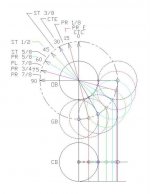I’ve recently started exploring with the manual pivot for CTE aiming after watching Stans video several times (I focused mostly on the Manual CTE part of the video) and I have questions that I could use some help clarifying.
Question 1: I was hoping somebody could explain the logic of the manual pivot for me. If I understand it correctly, it’s to bring you back to center cue ball. If this is the case, than why couldn’t you still maintain your CTE CB visuals but align your stance to center cue ball?
Question 2 – How to determine if the shot is calling for a right pivot or a left pivot? Does anybody have any suggestions that helped them through the learning process in determining if it should be a left pivot or a right pivot other than trial and error (which I am in the process of working through)? Initially (and maybe I was hoping a bit), that there was a constant variable which would determine the pivot direction. For example, if the CTEL was on the right, it was a right pivot and vice versa for the left. I know this is not the case but I do not understand why.
Additionally, here is an example that was provided in the practice worksheet for the “Manual” Basic CTE. On the practice sheet we have the two following shots which are cut shots to the same pocket.
First shot: CB: 21 OB: 13 CTEL: R OBP: B Pocket: 3 Pivot: L Angle: 22
Second shot: CB: 28 OB: 20 CTEL: R OBP: B Pocket: 3 Pivot: R Angle: 22
These are two very similar shots, for the exception of the distance of the object balls to the pocket but yet the pivot is different and Im not sure why.
Any clarification provided on the above would be greatly appreciated. Thanks in advance.
Question 1: I was hoping somebody could explain the logic of the manual pivot for me. If I understand it correctly, it’s to bring you back to center cue ball. If this is the case, than why couldn’t you still maintain your CTE CB visuals but align your stance to center cue ball?
Question 2 – How to determine if the shot is calling for a right pivot or a left pivot? Does anybody have any suggestions that helped them through the learning process in determining if it should be a left pivot or a right pivot other than trial and error (which I am in the process of working through)? Initially (and maybe I was hoping a bit), that there was a constant variable which would determine the pivot direction. For example, if the CTEL was on the right, it was a right pivot and vice versa for the left. I know this is not the case but I do not understand why.
Additionally, here is an example that was provided in the practice worksheet for the “Manual” Basic CTE. On the practice sheet we have the two following shots which are cut shots to the same pocket.
First shot: CB: 21 OB: 13 CTEL: R OBP: B Pocket: 3 Pivot: L Angle: 22
Second shot: CB: 28 OB: 20 CTEL: R OBP: B Pocket: 3 Pivot: R Angle: 22
These are two very similar shots, for the exception of the distance of the object balls to the pocket but yet the pivot is different and Im not sure why.
Any clarification provided on the above would be greatly appreciated. Thanks in advance.
